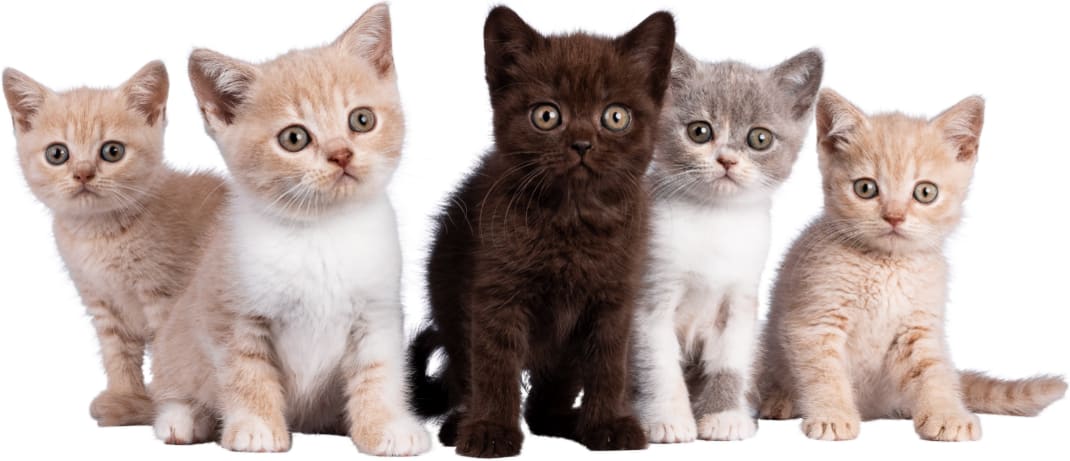Community Cats
Click images to enlarge
They have arrived and we need supplies! Kitten Season is here!

Click below to view our Amazon wishlist or donate:
As the warmer months arrive, unaltered (not spayed) female cats go into heat. If impregnated a female cat gives birth to a litter of kittens only 63 days later. As the influx comes in, the shelter must have enough resources to care for all them!
One of the easiest ways to prepare for "Kitten Season" is to ensure that commonly needed supplies are available immediately. To prepare for the inevitable, we are taking precautions so we are a step ahead! We need your help!
What is a community cat?
It Takes a Community
How to determine if a cat is an owned pet or is a community cat?
INTAKE METHOD
IDENTIFICATION
The Humane Society of Yuma uses the above-mentioned factors when determining if a cat is owned or is a community cat. If a cat is found/trapped outside and DOES NOT have any identification (i.e. a collar, identification tag or a microchip), the Humane Society of Yuma categorizes it as a community cat. Behavior is not a determining factor, because in a trap or shelter kennel, stress levels are high for any cat, owned/friendly or wild.
What is T.N.R.?
What should I do if a cat starts hanging around my house?
Why should I support TNR?
Goals
Humane TNR Practices
- All Cats must be in a humane cat trap. Cardboard boxes, cat carriers or cages are not permitted.
- All traps are to be labeled with the trapper or caretaker's name, phone number, and trapping location. All surgeries need to be scheduled before you trap the cats.
- Cat Traps should always be covered; this reduces stress and keeps all organic matter contained preventing the transfer of any contagious illnesses.
- Make sure that there are no anthills near the traps and please place only one cat per trap.
- Cats should be given 24 hours to recover and fed before being released.
- Do not attempt to hold the cats, if a bite occurs we are required by law to quarantine the animal for 10 days.
- Traps need to be thoroughly disinfected between each use. You will need a brush to scrub, bleach, and water.
Use a 1:10 ratio. For a 1:10 dilution, you should add 1 cup of bleach to 1 gallon of water. Or ¼ cup to 32 oz. of water.
Remember that bleach can burn. You should avoid exposing yourself and the cats to the fumes, and people should wear gloves and masks. Also, be sure there is adequate ventilation when using it. - Every cat will be sterilized, given a rabies vaccine & FVRCP, ear tip (on left ear), extended-release pain medication (lasts for 3 days), and medication if injury/illness is life-threatening. Additional vaccines, medication, and microchips can be administered upon request
- Please update your catstats.org/yuma account after returning your cat to its home.
Add-on prices for feral cats
- Microchip- $10
- FELV/FIV test- $28
- Feline Leukemia Vaccine (if test is negative)- $15
- FVRCP- $22
- Antibiotic Injection (lasts for 2 weeks)- $10
Trap Rental
TNR program cat trap rental agreement is available for our TNR appointments for spay and neuter of our community cats. A cash or check deposit of $95 is needed in exchange for the cat trap. The cat trap can be rented for up to 2 weeks. Once you return the cat trap in the condition it was in, your deposit will be returned to you. You must have a TNR appointment first before renting a cat trap.
Cat Deterrent
- Put out fragrances that keep cats away. Scatter fresh orange, grapefruit or lemon peels. Wet coffee grounds—which you may be able to get for free from coffee houses and fast food chains—and metal pans filled with vinegar also deter cats.
- Make an outdoor litter box away from your garden by tilling the soil or placing sand in an out-of-the-way spot in your yard. Clean the area frequently.
- Use plastic carpet runners, spike-side up, covered lightly in soil. They can be found at hardware or office supply stores. You can also set chicken wire firmly into the dirt (roll sharp edges under), arrange branches or sticks in a lattice pattern, or put wooden or plastic fencing over soil. “Plant” Plastic forks in the soil handle side down, tines sticking up. Old plastic chair mats can be cut to size for either burying lightly in the soil, spike side up or cut into longer stripes to add to the top of block walls to keep cats from traversing the tops.
- Place a “scat mat”, a nonchemical cat deterrent consisting of plastic mats that are cut into smaller pieces and pressed into the soil. Each mat has flexible plastic spikes that are harmless to cats and other animals but discourage digging.
- Get motion-activated sprinklers referred to as scarecrows. Sonic deterrents have also proved to be successful in keeping cats of vehicles when the sprinklers are not advisable.
- Cover exposed ground in flower beds with large river rocks to prevent cats from digging. Rocks have the added benefit of deterring weeds.
- Remove food sources from the area, do not feed other pets freely, and secure trash cans or dumpster lids without a food source the cats will move on to other areas
Register Your Colony
Registering your community cat colony allows you to receive important emails with information and T-N-R appointment dates.
Once you sign up and register your colony with the link above, click this link to schedule a surgery date. Chose "lion female" whether your community cat is male or female. Kittens MUST be 2 pounds to be altered.


